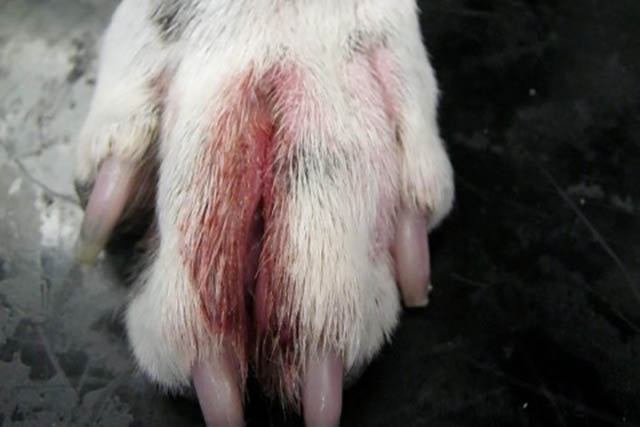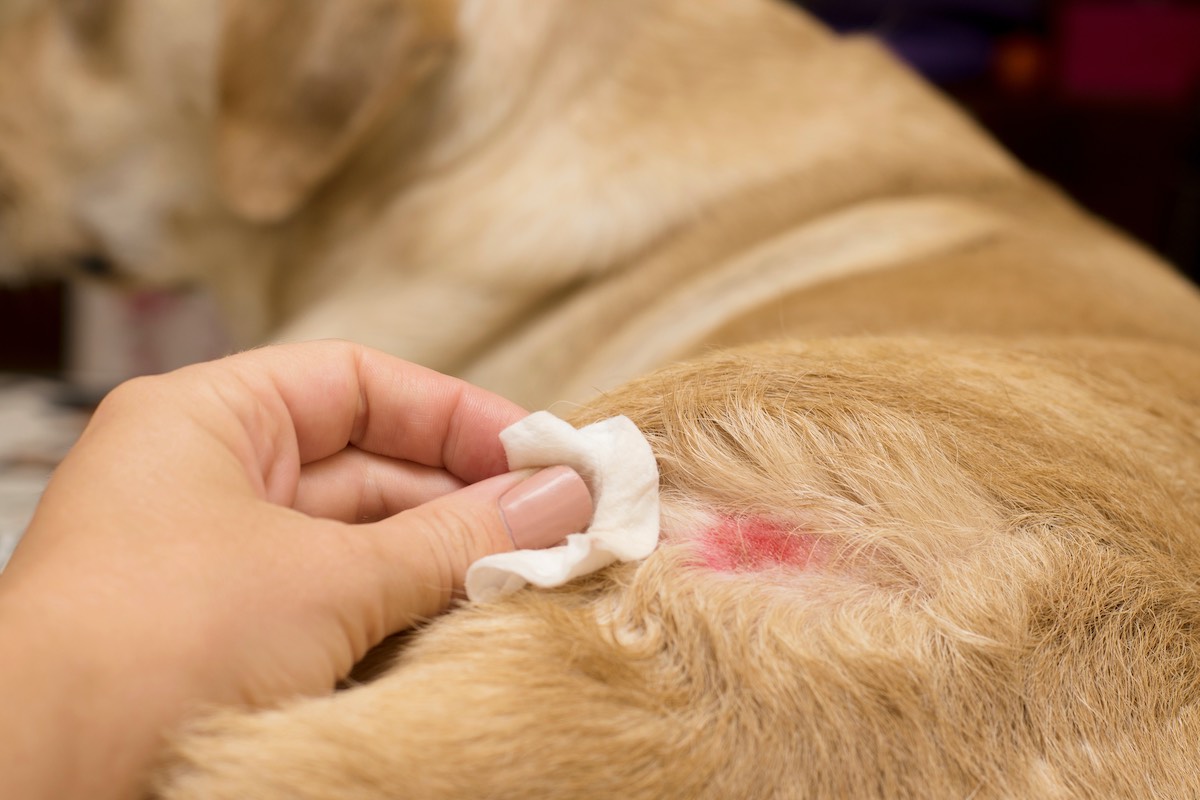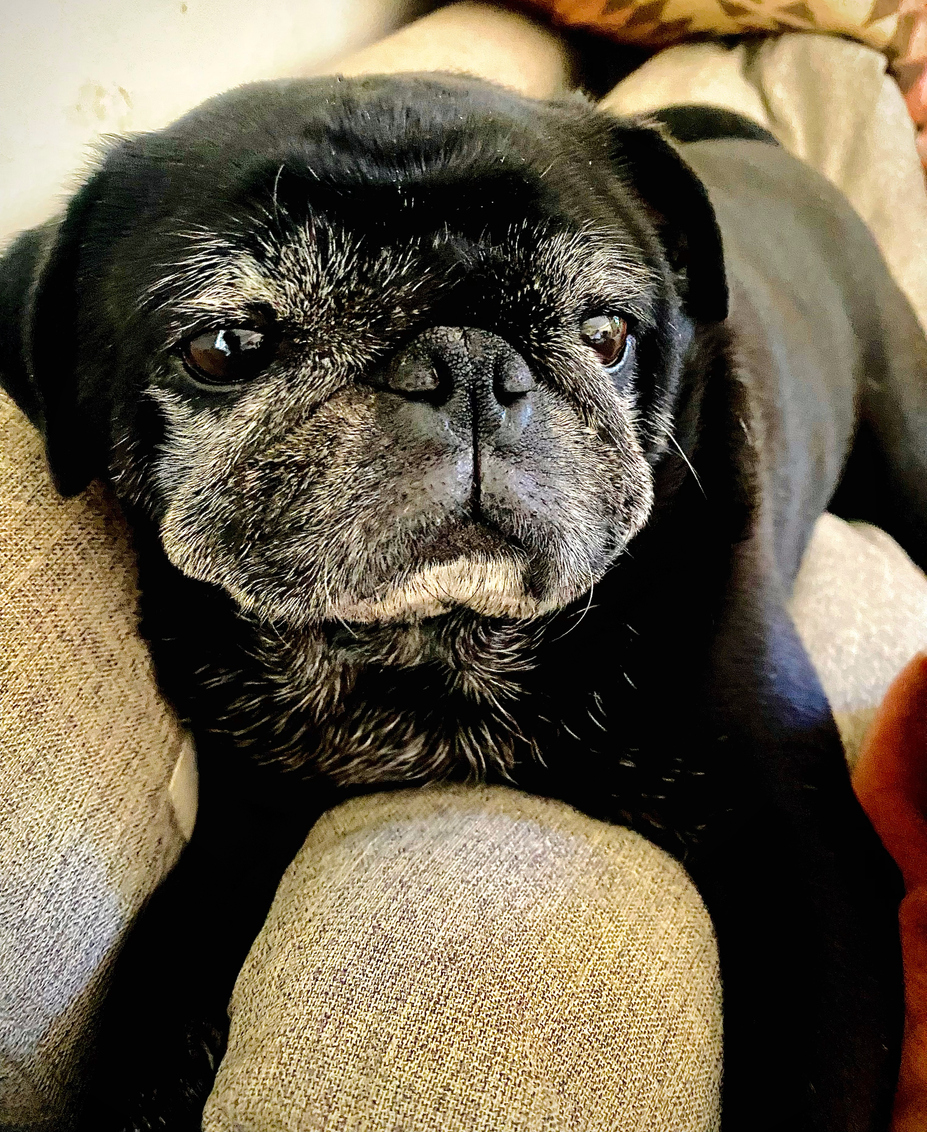Atopic Dermatitis in Dogs
What are allergies?
An allergy is a state of over-reactivity or hypersensitivity of the immune system to a particular substance called an allergen. Dogs with allergies develop a hypersensitivity reaction to substances (e.g., pollens, flea saliva, or food). Most dogs with allergies develop skin symptoms, especially itching, although the allergy may also affect the respiratory or digestive systems or the eyes.

What is atopic dermatitis?
With atopic dermatitis (atopy), the dog's immune system overreacts to an airborne allergen that gains entry to the skin due to a defective skin barrier. Other causes of allergies include fleas, certain dietary ingredients, skin contact with certain substances, and hypersensitivity to skin bacteria or yeast.
What are the clinical signs of atopic dermatitis?
Affected dogs chew, lick, and scratch all over, especially on the feet, face, axillae (armpits), and groin. There may be reddish-brown saliva staining of overly itchy areas. The skin will be red and chronic infection of the ears or skin, secondary to atopy, can lead to dark, thickened elephant-like skin. Clinical signs of atopy may recur or worsen in certain seasons if they are allergic to certain outdoor pollens or molds.
How is atopy diagnosed?
Your veterinarian will begin with a thorough physical examination of your dog. Your veterinarian will also take a complete patient history, asking you a variety of questions about your dog’s skin disease, to better characterize the condition. From the physical exam and history, your veterinarian may begin to suspect atopy as the cause of your dog’s skin disease.
Unfortunately, there is no definitive test for atopy. It is a diagnosis of exclusion, meaning that your veterinarian will rule out other, similar skin conditions to arrive at a diagnosis. The signs of atopy are identical to many other skin diseases. Your veterinarian will likely perform tests to rule out skin parasites (e.g., fleas, mites, and lice), bacterial and fungal skin infections, and ringworm. Biopsies may be performed to rule out autoimmune skin disease and other conditions. Your veterinarian may also recommend a food trial to rule out food allergies as a source of your dog’s skin issues. Ruling out other skin conditions is essential to arrive at a diagnosis of atopy.
Your veterinarian may perform tests to assess your dog’s overall health. These tests will help rule out underlying medical conditions and determine whether your dog can be safely treated with medications. Laboratory tests may include a complete blood cell count (CBC), serum biochemical profile, T4 (thyroid test), and urinalysis.
What causes this condition?
A wide variety of allergens can cause atopy, similar to the causes of hay fever or asthma in people. When the affected individual contacts dust, pollens, molds, or other allergens, an allergic response occurs.
How do you find the cause of my dog's allergy?
Diagnosis is not easy. It is based on the presence of clinical signs and ruling out other causes of pruritus (itchy skin) such as flea allergy dermatitis or food allergies. The clinical signs and itching caused by grass pollen are the same as those caused by house dust mites and many molds. In other words, your dog may be allergic to several different things with the result being the same: excessive itching and scratching. A thorough medical history will help narrow the causes. For example, if the itching occurs in the spring when certain pollen is present, this narrows the field of investigation.
I heard that my dog has to have allergy tests to make a diagnosis. Is this true?
Although allergy tests are not considered part of the diagnosis of atopic dermatitis (this diagnosis is based on clinical signs), allergy testing can be helpful to determine what your dog is allergic to.
There are two primary methods of allergy testing. The traditional allergy test is called intra-dermal allergy testing, or skin testing, and consists of injecting a tiny amount of an allergen into your dog’s skin. If the body produces a response to the allergen, it is allergic to that substance. A more recently developed allergy test, IgE allergy testing, involves taking a blood sample and testing it for the presence of IgE antibodies against specific allergens. If it contains a high number of these IgE antibodies, an allergy is presumed to exist. Your veterinarian will discuss the best type of testing for your dog’s condition.
Once the diagnosis has been made, it may be possible to desensitize your dog to the offending allergens. A specific allergy serum is made for your pet, according to the results of the allergy tests, and is given in a series of shots or liquid given under the tongue. The principle behind hyposensitization (allergy shots) is that the controlled doses of increasing amounts of the offending allergens will reprogram your dog's immune system and lessen its hypersensitivity. For about half of the treated dogs, these allergy injections result in significantly reduced itching.
If this does not work, what else can be done?
Anti-inflammatory drugs including corticosteroids, antihistamines, and other targeted therapies (addressing chemicals released within the skin during inflammation) will often bring relief from itching. Newer therapies including Oclacitinib (Apoquel®) and immunotherapeutic injections (Cytopoint®) are also available to control itch without the potential side effects of using corticosteroids.
Certain omega fatty acids (omega 3 and 6) provide some relief for many pets with allergic skin disease by reducing inflammatory chemicals within the skin. Antibiotics or antifungals may be required if there is a secondary bacterial or yeast skin infection (pyoderma) present. However, these products treat only the clinical signs, not the underlying allergy.
Many dogs benefit from frequent bathing with special shampoos, sprays, or mousses (topical therapy). Research shows that, because allergens are absorbed through the skin, frequent bathing may help reduce the amount of allergen that a dog absorbs. Some of the topical therapies incorporate omega fatty acids and ceramides, which may be absorbed into the skin, strengthening the skin barrier to help reduce the itching. Others will reduce the itchy overgrowth of yeast or bacteria on the skin.

My dog only itches in the spring and I have been told she has a seasonal allergy. What does this mean?
Seasonal allergy and atopy are terms used to describe the same type of allergic skin disease. The majority of dogs with atopy experience itching during certain seasons, when flowers or trees are blooming and producing pollens. Other affected dogs will have problems year-round, which means that the allergen is constantly present or that the dog has developed multiple allergies. A common cause of non-seasonal atopy is the house dust mite.
My dog has a grass allergy. Does that mean he should not walk on grass?
No. So-called grass allergies are more correctly termed grass pollen allergies. Pollens are airborne. Closely cut grass with no seeding heads will cause fewer problems for your dog, but there is little you can do to prevent your pet from being exposed to grass pollens.
Are there any other conditions connected with atopy?
Yes. Some dogs with atopy also have hypothyroidism (low thyroid gland production). Hypothyroidism affects the skin and may worsen allergic skin conditions. Dogs with chronic skin infections or allergies should be tested for hypothyroidism. If your dog has hypothyroidism, desensitization therapy and anti-inflammatory medications will often fail to help your pet unless the hypothyroid condition is also treated.
When my dog's allergies flare up, she seems to have a terrible smell. What causes this?
When allergies occur, the skin produces more sebum, which is an oily material that causes a musty odor. Once the itching and scratching are controlled, the odor and seborrhea should clear up. A skin or ear infection may also cause skin odor. Bacteria, fungi, and yeasts are all opportunists that can cause a secondary infection in dogs with underlying atopic dermatitis. The secondary infection may require specific antimicrobial treatment in addition to the allergy treatment.



